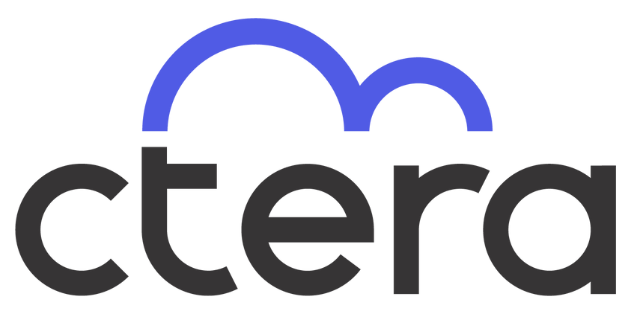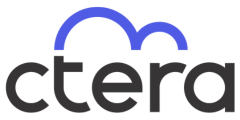
Overview

Product video
CTERA delivers the most comprehensive Intelligent Data Platform, modernizing traditional NAS, data protection, and unstructured data management. Combining the unlimited capacity and scalability of AWS S3 storage with real-time edge caching, immutable archiving, and AI-powered ransomware defense, CTERA ensures that critical data remains protected, accessible, and resilient.
The CTERA Intelligent Data Platform empowers a hybrid workforce with secure global file sharing and seamless remote access across on-premises, and the cloud, consolidating petabytes of unstructured data into a unified global namespace, accelerating AI initiatives and enhancing the productivity and operational efficiency of IT and data science teams.
Recognized as an industry leader by GigaOm for Cloud-Native Globally Distributed File Systems, CTERA has a proven track record serving Fortune 500 enterprises and government agencies worldwide.
Built for resilience and business continuity, the CTERA Intelligent Data Platform provides continuous data protection to Amazon S3, seamless disaster recovery, and priority data retrieval. Organizations accelerate productivity with highly available file presentation across distributed sites, enable collaboration across geo-dispersed locations, and support remote access without requiring a VPN.
Built on Zero Trust Architecture, the CTERA Intelligent Data Platform features immutable volumes, machine learning driven ransomware detection and enforcement, end-to-end encryption with private key management, and built-in data migration and discovery tools. It delivers unmatched flexibility and cyber resiliency, with active and passive controls to identify and remediate cyber incidents, and is trusted as the only global file system approved by the U.S. Department of Defense.
Highlights
- Modernize distributed NAS environments with CTERA Enterprise Data Services for AWS, leveraging cost-effective Amazon S3 storage, edge caching, real-time replication, and global deduplication to optimize operational efficiency and business continuity.
- Enhance data protection and cyber resilience with AI-powered ransomware detection, immutable WORM volumes, FIPS 140-3 certified encryption, and continuous data replication to Amazon S3, ensuring enterprise-grade security for globally distributed teams.
- Centralize management of thousands of distributed edge locations with CTERA Portal, providing unified global namespace access, automated software updates, proactive monitoring, and seamless hybrid workforce productivity without a VPN.
Details
Introducing multi-product solutions
You can now purchase comprehensive solutions tailored to use cases and industries.

Features and programs
Buyer guide

Financing for AWS Marketplace purchases

Pricing
Dimension | Description | Cost/12 months |
|---|---|---|
CTERA Hosted Data Services | Hosted CTERA Portal tenant. Centralize file storage, streamline data protection and disaster recovery, enhance user productivity with remote access and seamless file sharing across globally distributed sites. Starting pricing reflected | $12,000.00 |
CTERA Private Data Services | Private CTERA Portal deployment in your AWS Virtual Private Cloud (VPC). Centralize file storage, streamline data protection and disaster recovery, enhance user productivity with remote access and seamless file sharing across globally distributed sites. Starting pricing reflected | $40,000.00 |
Vendor refund policy
Refunds are not available
How can we make this page better?

Legal
Vendor terms and conditions
Content disclaimer
Delivery details
Software as a Service (SaaS)
SaaS delivers cloud-based software applications directly to customers over the internet. You can access these applications through a subscription model. You will pay recurring monthly usage fees through your AWS bill, while AWS handles deployment and infrastructure management, ensuring scalability, reliability, and seamless integration with other AWS services.
Resources
Support
Vendor support
CTERA Networks is committed to delivering comprehensive support to ensure the success of our customers. Buyers of our products can access a range of support services designed to meet enterprise needs. Enterprise Support: Our dedicated team of CTERA experts is available to assist with any technical issues or inquiries. Training Programs: CTERA offers online, self-paced Partner Certifications and Administrator Training to help users maximize the value of our solutions.
Contact Information:
- Email: info@ctera.com
- Support Page: https://www.ctera.com/support/
- Phone (USA): +1 (917) 768-7193 For more detailed information about our support services, visit:
AWS infrastructure support
AWS Support is a one-on-one, fast-response support channel that is staffed 24x7x365 with experienced and technical support engineers. The service helps customers of all sizes and technical abilities to successfully utilize the products and features provided by Amazon Web Services.
Similar products





Customer reviews
Effortless Caching and Seamless Data Access
Unified, Secure, and Efficient File Management Made Easy
CTERA solves this by providing a hybrid cloud global file system that keeps frequently accessed data available locally on edge filers while automatically syncing to the cloud for continuity and protection. This eliminates the performance issues we previously faced with traditional file servers and improves user productivity across multiple buildings and locations.
It also helps us address business problems such as:
Reliable access to large files (e.g., body cam videos) without latency.
Centralized management of distributed storage instead of maintaining multiple complex servers.
Snapshot-based protection that enhances our data recovery and ransomware resilience.
Seamless collaboration between multiple units without version conflicts.
Reduced storage footprint at remote locations due to intelligent caching.
Overall, CTERA enables us to maintain secure, high-performance access to sensitive data while modernizing our infrastructure and reducing operational overhead.
Supports global file recovery and rapid data versioning across 80 nodes
What is our primary use case?
We have approximately 80 nodes around the world and we're using CTERA Enterprise File Services Platform mostly for unstructured file storage.
What is most valuable?
I appreciate the recoverability of CTERA Enterprise File Services Platform , the fact that we have cloud sync working and we're able to use versioning as well as recovery of deleted files. It really makes life easy because people tend to change things and delete things when they don't mean to.
That's probably one of my favorite features of CTERA Enterprise File Services Platform, but I also appreciate the fact that it's very flexible. It seems to be fairly bandwidth compliant, so we're always looking at ensuring we don't overload our circuits, especially when we're doing our cloud syncs.
CTERA Enterprise File Services Platform has helped free up our IT resources for other projects and tasks. It's been very easy. When we do see issues, their support is top-notch and very responsive when we need help. It has really made it easier for us to be able to globally assign storage. We're putting local nodes rather than trying to put them in data centers and really having problems with overall timing. We always want our data close to our applications and our people. In this case, it helps a lot to maintain that.
We use CTERA Enterprise File Services Platform a lot because typically end users are not very good stewards of their own data, and CTERA Enterprise File Services Platform helps us when they break something or lose things. We had an incident in Illinois where we had to recover an entire directory because somebody deleted all the files, and we were able to do that. Someone also came to us saying they changed a huge spreadsheet they had been working on for months and needed to go back a version. That makes us look really good because we're able to quickly respond to those types of requests. It makes people think I have my superhero cape on because they're thinking it's all lost, they're doomed, and we're able to quickly and effectively go back and say, "Here you go," and it's not hours, it's minutes.
CTERA Enterprise File Services Platform is extremely scalable. For us it's probably about a 15-minute process when, especially in the cloud sync, somebody drops a large volume of data. I'm easily able to add on. They come in 50-terabyte chunks, so that's pretty scalable in my mind. It's not a huge oversell, so it's a pretty sweet spot for us when we're adding in new sites or new data, especially when it comes to doing desktop image backups and things of that nature. Someone might come to me saying, "Hey, I need a 10-terabyte node," and I'm easily able to spin that up within hours, not days.
What needs improvement?
When we implemented CTERA Enterprise File Services Platform early on, and we've been on the platform for three years, we have three different cloud portals. We have an EU portal, we have an Americas portal, and we have an APAC portal. It would be nice if we could combine that into one portal just for that global single pane of glass look. We've talked with them about that and they say it's challenging just because of some of the structure, but that would be something nice if we could get that. I integrated with Varonis, and because CTERA Enterprise File Services Platform didn't have initially a working relationship with that vendor, it would have been nice had that pre-existed us saying we need this. But that wasn't totally CTERA's fault. There was a lot of challenge working with the vendor to build out that interface.
A single pane of glass for CTERA Enterprise File Services Platform would be beneficial. Everything else works fairly well. We've never had a point where we couldn't get to something that caused us to have a serious outage, and that to me is the mark of a good software package. It's never really caused us serious issues. We have our issues, that's true, and every software package does. However, we've always been able to meet the needs of the business, and we drive hard on security, stability, and scalability. From the scalability standpoint, that's one of the most important things to us. We're on their capacity-based licensing, so if I need to ramp up another CTERA Enterprise File Services Platform NAS , if we have an M&A, I can easily and quickly spin up another NAS and start doing that data transition fairly quickly.
The biggest maintenance issue with CTERA Enterprise File Services Platform is firmware upgrades. We've done a lot of transition from hardware solution to virtualized infrastructure in order to minimize that hardware lifecycle portion of it. We have to upgrade the firmware and sometimes that can be challenging in the nature of business of our size with 80 CTERA Enterprise File Services Platform nodes around the globe.
The issue we've had with CTERA Enterprise File Services Platform happened recently in a firmware upgrade where there was a major database back-end upgrade and that took some time. For our smaller sites, it would be an hour or two, and I can build that into a fairly easy change window. But in our larger sites where we may have hundreds of terabytes of data, that database update process took maybe a day or a day and a half. That becomes more challenging, especially in a manufacturing environment where people are wanting to access configuration files. We had to pin the data locally because the data would be available on the local edge filer, but the cloud sync, while it was updating the database, the cloud files weren't available. That would be the other thing I'd like to see an improvement on: some way to do those database upgrades either in a more segmented fashion or in some type of offline environment. I understand the logistics behind that sounds easy, but I'm sure it's not.
For how long have I used the solution?
We've been using CTERA Enterprise File Services Platform for approximately seven years.
What do I think about the stability of the solution?
We haven't had stability issues from CTERA Enterprise File Services Platform side. I've seen some challenges where users tried to use a NAS device in what I'll call an inappropriate method. We just had a recent instance where some of our users were storing Access databases out on a NAS, which the documentation clearly states is a bad idea. They bent over backwards to try and help us make it work, and we were able to do some things there. More often than not, we've never had any other types of issues from the CTERA side.
How are customer service and support?
The learning curve for CTERA Enterprise File Services Platform for our employees is not bad. When we have questions, support's been very responsive for us.
CTERA Enterprise File Services Platform has helped free up our IT resources for other projects and tasks. It's been very easy. When we do see issues, their support is top-notch and very responsive when we need help. It has really made it easier for us to be able to globally assign storage by putting local nodes rather than trying to put them in data centers and having problems with overall timing. We always want our data close to our applications and our people, and in this case, it helps a lot to maintain that.
The quality and speed of support for CTERA Enterprise File Services Platform is some of the best in the industry. I've worked with a lot of different companies through the years, and even from simple questions to complex ones, they've been very responsive. To the point where sometimes I wonder when our dedicated support engineer sleeps.
Several of our people have taken their admin training class for CTERA Enterprise File Services Platform, which obviously helps a lot because it gives an in-depth look at the operational factors involved.
How would you rate customer service and support?
Positive
How was the initial setup?
I was not around when CTERA Enterprise File Services Platform was fully onboarded. However, I'm sure it was not a short process just because of our volume of data. We're storing currently right around 2.2 petabytes.
What other advice do I have?
From an application standpoint concerning the Ransom Protect feature, it's not really that pertinent, but from a global support team perspective, we have a follow-the-support model. It helps that we're able to quickly respond globally to incidents, whether that be in APAC, EU, or the US. They're very good about making sure that we have the ability to do that.
I'd like to see a Varonis integration natively with CTERA Enterprise File Services Platform.
Database upgrades in a segmented fashion or offline for CTERA Enterprise File Services Platform would be beneficial. This review has been given a rating of 8 out of 10.